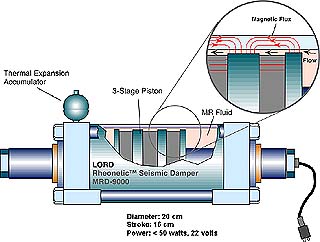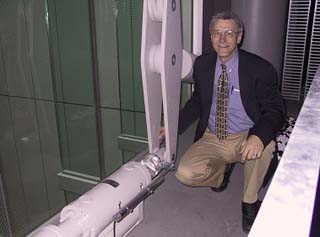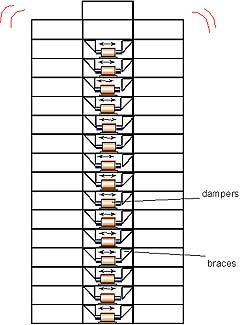
Surveys
AIA Awards
DJC.COM
November 20, 2003
Special dampers may shake up engineering field
Special to the Journal
The company that developed Delphi's high-tech MagneRide shock absorbers for late model Cadillacs and Corvettes is now promoting its proprietary shock-dampening technology on a larger scale — to protect bridges and buildings from earthquakes and wind storms.

Images © 2003 Lord Corp.
Magnetic fluid dampers work by turning a small electric current on and off in milliseconds to change the fluid inside from liquid to solid and back.
|
At the core of Lord Corp.'s magneto-rheological (MR) fluid technology is the fact that when a small DC electric current passes through fluid containing tiny particles of carbonyl iron, the floating particles instantly line up in rows that make the fluid rigid. When the current stops, it becomes fluid again.
Because the current can be turned on and off in milliseconds, the oily liquid transforms itself from a liquid to a solid and back again so instantaneously that it can significantly dampen shocks from potholes, speed bumps or washboard roadways.
Now the Cary, N.C., company is putting a variety of MR shock absorbers on bridges and buildings.
In China, for instance, sharp-eyed drivers on the Dong Ting Lake Bridge in Hunan Province may have noticed that one of the hundreds of 10-inch-diameter steel support cables was stable, while all of the others were vibrating or swaying — often as much as 4 feet — in high winds.
“That's a scary thought,” said Lynn Yanyo, Lord Corp.'s manager of sales and marketing. “But with our ‘smart' MR-fluid shock absorbers installed on that cable, we were able to eliminate the resonance vibrations that could have damaged the bridge. A video on our Web site shows the dramatic differences in the cables.”

Dr. David Carlson, Lord Corp. engineering fellow, shows off a Rheonetic damper in Japan’s National Museum of Emerging Science and Innovation. |
The Chinese were impressed enough with the results of the MR dampening device that they hired Lord to retrofit all of the bridge cables. Now the government is incorporating the MR system into plans for new bridges in high-wind areas.
“They didn't have to be pressured. They needed technology that worked. When they checked out the MR system it sold itself,” Yanyo said.
As research into MR fluids has grown in recent years, the Lord Corp. has emerged a leader in developing commercially viable products based on that technology.
“The technology is actually 50 years old, but it never went anywhere until the age of computers, sensors and controllers made high-tech applications possible,” Yanyo said.
Lord's engineers have taken MR fluid devices from research curiosities to commercial uses in less than 10 years. Now one of the greatest potentials for MR fluid technology appears to be protecting buildings from seismic and wind pressures that could destroy them, she said.
In Japan, the new seven-story National Museum of Emerging Science and Innovation, housing an interactive array of some of the world's most scientifically creative concepts, has been built with a unique earthquake control system using Lord's custom-designed Rheonetic fluid dampers. The devices are also featured in one of the museum's exhibits.
Inside a MR-fluid damper, an electromagnetic coil is wrapped around three sections of a piston. About five liters of MR fluid fills the damper's main chamber. During an earthquake, sensors attached to the building signal the computer to supply the dampers with a small amperage DC electrical charge.
The magnetized coil instantly turns the liquid into a solid, then to a liquid again as the charge is turned off. Repeating that sequence in milliseconds allows the fluid to absorb the seismic or wind pressures against the building.
With MR-fluid dampers throughout a structure, the response to seismic activity or high winds can be automatically adjusted to mitigate a variety of actual intensities distributed throughout a building, compared to passive dampening systems designed to only resist a particular intensity of energy, she said.
“The MR devices are not dependent on a particular velocity to react and they response to differing pressures on every floor individually,” Yanyo said. “Also, they can be re-used repeatedly to defend against aftershocks or the next big quake, whereas some shock absorbing systems or materials in buildings can only be stressed once.”

Placing shock-dampening units on each floor of a building could absorb the shock of quakes and windstorms, just as auto shock absorbers dampen road hazards.
|
If there was a power outage during an earthquake or windstorm, the MR systems fail safely to a passive dampening mode, but they can also be operated by DC power from batteries or UPS systems.
There are no moving parts in MR damper, which minimizes maintenance needs and decreases the size of the devices, which operate under extreme environmental conditions ranging from -40C to 130C.
John Tessem, a principal with Cary Kopczynski & Co. in Bellevue, a structural engineering firm, said he first heard of MR technology at a 2002 American Society of Civil Engineers Structures Conference in Denver.
“From the technical paper at the conference it seemed rather fascinating, a nifty idea,” Tessem said. “But it would take a very special building to warrant the cost (of MR dampers) and retrofitting would be even more expensive.”
John Hooper, director of earthquake engineering at Magnusson Klemencic Associates, said he's seen articles on MR fluid technology and he's been pursuing his own research into dampening systems for high-rise buildings.
“We already have as many as 20 high-rise buildings in Seattle with seismic dampers, including the Columbia Tower. Some use friction systems and others have visco-elastic types designed to lessen the impact of earthquakes. If this technology is another opportunity to reduce (quake) impacts then I'd look into it,” he said.
Although costs of the “smart” MR dampening systems are often comparable to passive systems, Yanyo said, “there are some buildings, bridges or elevated freeways that need the protection of MR systems (even if the costs were higher) simply because of their importance to society.”
For more information about MR technology, visit www.mrfluid.com.
Terry Stephens is a freelance writer based in Arlington. He can be reached by e-mail at features@gte.net.
Other Stories:
- Today's buildings load up on technology
- Letting rainwater reign in the design process
- Church praises the benefits of adaptive re-use
- UW builds on design leadership training
- Science studies how architecture affects the brain
- China creates a park with environmental appeal
- How the Great Fire changed Seattle's architecture
- Architects play catch-up in the business world
- Designing with nature in the balance
- 12 keys to creating authentic people places
- Monorail to move urban design as well as people
- Water tower repairs borrow on building technology
- Technology takes center stage in performance halls
- Don't be violated — protect plans with copyrights
- UW Allen Center fosters a culture of research
- Here's why projects need to be commissioned
- Unwrapping modern building envelopes
- Lessons on sustainability, Scandinavian style
- Building a highrise on the fault line
- How to keep development from killing trees
- Rx for changing healthcare industry: Good design
- In hospitals, spending more can save money
- Muckleshoot project blends culture with design
Copyright ©2009 Seattle Daily Journal and DJC.COM.
Comments? Questions? Contact us.